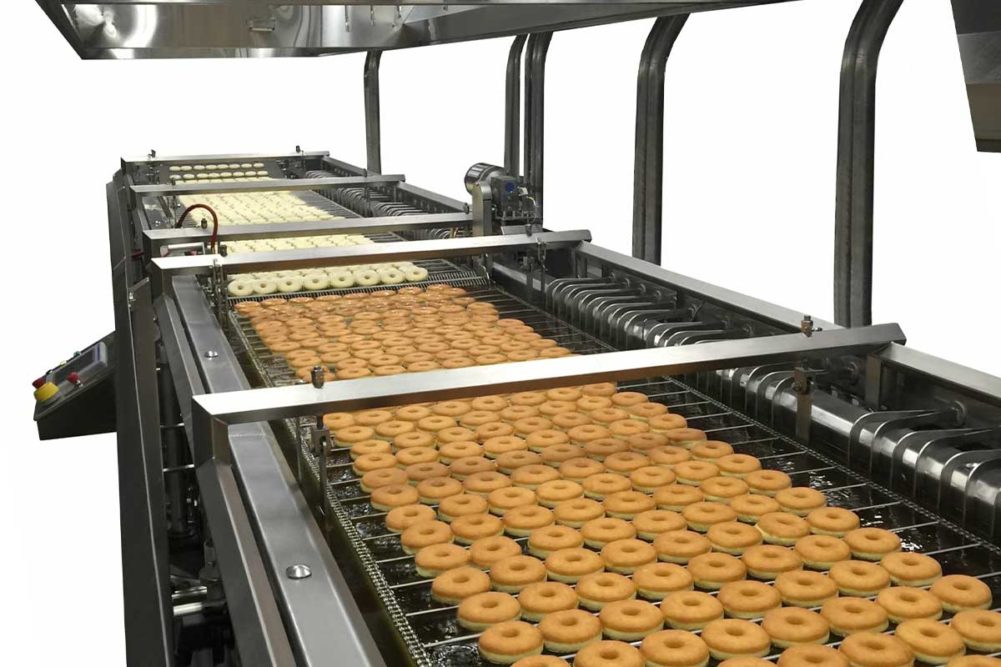What is a donut without a glaze, icing or filling? From jelly to frosting, the application and finish of a donut rely on several variables that affect the quality and consistency of the final product. Temperature and humidity play a role in how consistently icings can be applied. Even application relies on temperature, along with viscosities and the durability of the donut itself during filling. And when a production line is intended for various types of donuts, changeover can be tricky and a cause for downtime if not thought through carefully.
Today, donut operations are beginning to see a shift in processing. To keep up with changing trends, bakers will need to ensure their formulations and equipment are in sync with the demands of the product, and that quality can be maintained as donuts are iced, filled, fried and frozen.
The key to maintaining product quality when applying an icing to a donut is all in the temperature. It is a variable of the process that needs to be controlled throughout the entirety of the production line, from the very beginning to the very end.
“When it comes to icing systems, there’s really two main parts: There’s the icing preparation, and then there’s the icing application,” said David Moline, vice president of sales and marketing, Moline Machinery. “Temperature and humidity are critical, and they especially play a factor in the preparation area.”
However, it is important to note that temperature and humidity both can affect the icing process in different ways.
“Usually if the temperature is too cold, icings like buttercream and fudge are too stiff to operate with a depositor,” said Chris Hatch, business development manager, Unifiller. “The icing may bridge and not travel through to the cake. On the other hand, if the icing such as buttercream, fudge and cream cheese is too warm, it will fall off the cake or worse fall off in transit after freezing. Whipped cream, on the other hand, works best at cooler temperatures.”
Systems are built specifically to better maintain temperature to avoid effects such as melting or crusting.
“The challenge is to keep the icing at an even temperature and without any hot spots, which can cause crusting,” said Mike Baxter, sales and marketing, Belshaw Adamatic. “An automated icer relies on a well-designed stirring mechanism built right into the tank. The tank itself is very gently heated by hot water to prevent hot spots from forming in the first place. The combination of these two design features works to minimize any crusting.”
Though there are many variables that require keen attention, bakers do not need to stress. There are several methods for finding the correct formula for a specific product’s icing.
“You need to determine the ideal temperature and humidity for each product, then standardize processes to ensure quality standards,” Mr. Hatch said. “First, measure the specific gravity of the icings during production to ensure that the standards are met.”
Then, check the temperature so that it can be compared to the ideal operating range.
“And always mix icing fresh and use equipment with a minimal dwell-time,” he added. “If icing sits too long, it will gas out and require more manual touch-up.”
Another variable to consider is a recent shift in wholesale donut manufacturing: freezing the completely finished and iced donuts.
“One of the more obvious trends that I’ve seen in recent history is for fully finished and half-iced finished donuts at the wholesale manufacturing level,” Mr. Moline said. “In the past, it was very common to have a pre-fried system where unfinished product is shipped to their retail location and then finished on site.”
That trend, he said, is moving to finishing at the manufacturing level. With this transition comes a lot of new considerations for the design and layout of the production line.
“It affects the operation process in a pretty big way,” Mr. Moline said. “Processing times are extremely important, especially on a continuous line. If you’re talking about half-icing, you have to be cognizant of what the internal temperature of the donut is when the icing is applied. And the whole system, the conveyors and everything after the donut is fried, must have adequate cooling time so that icing is not going to melt off after it is applied.”
A lot of the importance in preparing an iced donut for freezing lies in the preparation of the icing and the handling of the icing before and during application. Formulation is also key.
“It’s a fair statement that finishes such as icing will use formulations that are tailored for frozen or non-frozen products,” Mr. Moline said. “Some icings that are formulated for frozen donuts tend to set more quickly, and therefore, they also have to be heated to higher temperatures than retail icing for a fresh donut. So when you’re considering your icing equipment, you absolutely have to consider whether it’s in a fresh or a frozen process, and the formulation is often going to decide your icing process as a whole.”
Icing suppliers can recommend certain types of formulations, but this requires an open dialogue between the baker, the ingredient supplier and equipment manufacturers to get the proper systems to make the correct formulations and applications possible.
“It is absolutely critical, especially with icings that are formulated for frozen donuts, to have an extremely consistent humidity and extremely consistent temperature,” Mr. Moline said. “Ambient temperature does play a factor, but as far as controlling the temperature of your icing before and after the applicator, it is extremely important to consistency.”
This article is an excerpt from the September 2021 issue of Baking & Snack. To read the entire feature on Donuts, click here.





